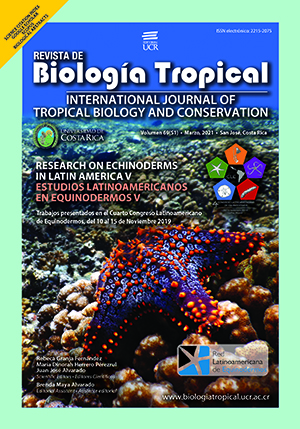Abstract
Introduction: Eucidaris thouarsii is a cidaroid sea urchin found from the Gulf of California to Ecuador. Its taxonomy is based on general descriptions of test shape, primary and secondary spines, the Aristotle’s lantern, apical system, and peristome. Objective: To redescribe E. thouarsii with detailed descriptions, adding new taxonomic characters. Methods: We examined and reidentified 792 specimens, measuring and analyzing in detail structures of taxonomic value. Results: The horizontal diameter of the test ranges from 2.8 to 48.45 mm; the peristome corresponds to 40-60 % of that diameter, proportionally bigger than the apical system; the interambulacral areas are four times larger than the ambulacral areas. The variation of the pedicellariae is shown with scanning electron microscopy. The specimens of the Mexican oceanic islands are markedly different when compared to those of the mainland. Conclusions: Eucidaris thouarsii has five well differentiated secondary spines, and also specific regionalization; the apical system varies according to the size of the Horizontal Diameter of the Test; the globiferous pedicellariae have intraspecific differences; and the tridentate pedicellariae are specifically regionalized.
References
Agassiz, A. (1863). List of the Echinoderms sent to different Institutions in exchange for other specimens, with annotations. Bulletin of the Museum of Comparative Zoology Cambridge, Massachusetts, 1(2), 17-28.
Agassiz, A. (1872-1874). Revision of the Echini. Memoirs Museum of Comparative Zoology at Harvard College, 3(1-4), 1-744.
Agassiz, L., & Desor, P.J.E. (1846). Catalogue raisonné des familles, des genres, et des espèces de la classe des échinodermes. Annales des Sciences Naturelles, Troisième Série, Zoologie, 6, 305-374.
Birkeland, C., Mayer, D.L., Stames, J.P., & Buford, C.L. (1975). Sublitoral communities of Malpelo Island. Smithsonian Contributons to Zoology, 175, 55-58.
Boone, L. (1926). Echinoderms from the Gulf of California and the Perlas Islands: Scientific Results of the Second Oceanographic Expedition of the “Pawnee”. Bulletin of the Bingham Oceanographic Collection, 2(6), 1-14.
Boone, L. (1933). Scientific results of the cruises of the yachts “Eagle” and “Alva”, 1921- 1928, William K. Vanderbit, Commanding. Coelenterata, Echinodermata and Mollusca. Bulletin of the Vanderbilt Marine Museum. Huntington, 4, 1-217.
Caso, M.E. (1953). Estado actual de los conocimientos acerca de la fauna de los equinodermos de México. México: Memoria del Congreso Científico Mexicano, Universidad Nacional Autónoma de México.
Caso, M.E. (1961). Estado actual de los conocimientos acerca de equinodermos de México (Doctoral thesis). Universidad Nacional Autónoma de México, México.
Caso, M.E. (1962). Estudios sobre equinodermos de México. Contribución al conocimiento de los equinodermos de las islas Revillagigedo. Anales del Instituto de Biología. Universidad Nacional Autónoma de México, 33(1-2), 293-330.
Caso, M.E. (1976). El estado actual del estudio de los equinodermos de México. Anales del Centro de Ciencias del Mar y Limnología, Universidad Nacional Autónoma de México, 3(1), 1-56.
Caso, M.E. (1978). Los equinoideos del Pacífico de México. Parte 1. Órdenes Cidaroidea y Auldonta. Parte 2. Órdenes Stiridonta y Camarodonta. Anales del Centro de Ciencias del Mar y Limnología, Universidad Nacional Autónoma de México, Publicación especial,1, 1-244.
Clark, A.H. (1939). Echinoderms (others than Holothurians). Smithsonian Miscellaneous Collections, 98(1), 1-18.
Clark, A.H. (1946). Echinoderms from the Pearl Islands. Bay of Panamá with a revision of the Pacific Species. Smithsonian Miscellaneous Collections, 106(5), 1-11.
Clark, H.L. (1902). Papers from Hopkins Stanford Galapagos expedition, 1898-1899.XII. Echinodermata. Proceedings of the Whashington Academy of Sciences, 4, 521-531.
Clark, H.L. (1907). The Cidaridae. Bulletin of the Museum of Comparative Zöology. Harvard College, 51(7), 165-228.
Clark, H.L. (1913). Echinoderms from Lower California, with descriptions of new species. Museum of Comparative Zöology at Harvard College, 32, 185-236.
Clark, H.L. (1923). Echinoderms from Lower California with descriptions of new species. Supplementary report. Bulletin of the Museum of Comparative Zoölogy at Harvard College, 48(6), 147-163.
Clark, H.L. (1940). Notes on Echinoderms from the West Coast of Central America. Zoologica, 25, 331-352.
Clark, H.L. (1948). A report on the Echini of the warmer Eastern Pacific, based on the collections of the “Velero III”. Allan Hancock Pacific Expeditions, 8, 225-351.
Conejeros-Vargas, C.A. (2015). Taxonomía y distribución de los equinodermos (Echinodermata) de las costas de Michoacán, México (Bachelor thesis).Universidad Nacional Autónoma de México, México.
Coppard, S.E., Kroh, A., & Smith, A.B. (2012). The evolution of pedicellariae in echinoids: an arms race against pests and parasites. Acta Zoologica (Stockholm), 93, 125-148.
Döderlein, L. (1887). Japanischen Seeigel. Stuttgart E. Schweizerlart’sche Verlagshandlung.
Ebert, T.A. (1988). Growth, Regeneration, and Damage Repair of Spines of the Slate-Pencil Sea Urchin Heterocentrotus mammillatus (L.) (Echinodermata: Echinoidea). Pacific Science, 42, 160-172.
Lamarck, J. B. M. (1816). Histoire naturelle des animaux sans vertèbres, Tome troisième (Histoire naturelle des animaux sans vertèbres présentant les caractéres généraux et particuliers de ces animaux, leur distribution, leurs classes, leurs familles, leurs genres, et la citation des principales espèces qui s’y rapportent). Paris: Deterville/Verdière.
Leske, N.G. (1778). Iacobi Theodori Klein Naturalem dispositionim echinodermatum. Accesserunt Lucubratiuncula de aculeis echinorum marinorum et spicilegium de belemnitis edita et descriptionibus novisque inventis et synonomis auctorem aucta. Ex Officina Gleditschiana, Lipsiae, 23, 1-278.
Lessios, H.A., Kessing, B.D., Robertson, D.R., & Paulay, G. (1999). Phylogeography of the pantropical sea urchin Eucidaris in relation to land barriers and ocean currents. Evolution, 53(3), 806-817.
Lockington, W.N. (1875-1876). List of Echinidae now in the collection of the California Academy. Proceedings of the California Academy of Sciences, 6, 152-159.
Maluf, L.Y. (1988). Composition and distribution of the central Eastern Pacific Echinoderms. Natural History Museum of Los Angeles County Technical Reports, 2, 1-242.
Mortensen, H.T. (1921). Studies of the development and larval of Echinoderms. Copenhagen: C.A. Rietzel Publisher.
Mortensen, H.T. (1928). A monograph of the Echinoidea I. Cidaroidea. Copenhagen: C.A. Rietzel Publisher, Oxford University press.
Mortensen, H.T. (1950). Reports of the BANZAR Antarctic Research Expedition 1929-1931: Echinoidea. The BANZAR Expedition Committee, Adelaide. 4(10), 287-309.
Pomel, M.A. (1883). Clasificación metódica y genérica de los equinoideos vivos y fósiles (Doctoral thesis). Academia de Paris, France.
Ziesenhenne, F.C. (1937). The Templeton Crocker Expedition. Echinoderms from the West Coast of Lower California, the Gulf of California and Clarion Island. Zoologica, 22(3), 209-239.
##plugins.facebook.comentarios##

This work is licensed under a Creative Commons Attribution 4.0 International License.


